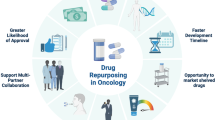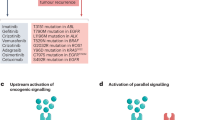Abstract
Advances in our understanding of cancer biology have led to the discovery of a spectrum of new therapeutic targets. However, despite remarkable progress in the identification and characterization of novel mechanisms of the oncogenic process, the success rate for approval of oncology drugs remains low relative to other therapeutic areas. Innovative preclinical and clinical approaches, such as the use of advanced genomic technologies, as well as branched adaptive clinical trial designs, have the potential to accelerate the development and approval of highly effective oncology drugs, along with a matching diagnostic test to identify those patients most likely to benefit from the new treatment. To maximize the effectiveness of these new strategies, close collaboration between academic, industry, and regulatory agencies will be required. In this Review, we highlight new approaches in preclinical and clinical drug development that will help accelerate approval of drugs, and aim to provide more-effective treatments alongside companion diagnostic tests to ensure the right treatment is given to the right patient.
Key Points
-
Traditional approaches to preclinical and clinical development of anticancer agents have a poor track record of success and are not sustainable from an industry perspective
-
There have been significant advances in the preclinical development of targeted anticancer therapies that may improve the clinical success rate
-
New clinical trial approaches are available that may improve selection of the best dose, as well as better identify responsive patients via co-development of a companion diagnostic test
-
There are increasing examples of academic–industry collaborations to develop public databases containing linked clinical and biomarker information, which have the potential to accelerate development of highly effective anticancer drugs
This is a preview of subscription content, access via your institution
Access options
Subscribe to this journal
Receive 12 print issues and online access
$209.00 per year
only $17.42 per issue
Buy this article
- Purchase on Springer Link
- Instant access to full article PDF
Prices may be subject to local taxes which are calculated during checkout



Similar content being viewed by others
References
Pettersson, A., Arnold, C. & Beever, C. Pharma R&D: Doing the same thing that didn't work before. In Vivo 27, 2009800072 (2009).
DiMasi, J. A., Feldman, L., Seckler, A. & Wilson, A. Trends in risks associated with new drug development: success rates for investigational drugs. Clin. Pharmacol. Ther. 87, 272–277 (2010).
Hutchinson, L. & Kirk, R. High drug attrition rates—-where are we going wrong? Nat. Rev. Clin. Oncol. 8, 189–190 (2011).
Maitland, M. L. Volumes to learn: advancing therapeutics with innovative computed tomography image data analysis. Clin. Cancer Res. 16, 4493–4495 (2010).
Hodi, F. S. et al. Improved survival with ipilimumab in patients with metastatic melanoma. N. Engl. J. Med. 363, 711–723 (2010).
Dickson, R. et al. Ipilimumab for previously treated unresectable malignant melanoma: A Single Technology Appraisal. LRiG, The University of Liverpool [online], (2011).
Trowman, R., Chung, H., Longson, C., Littlejohns, P. & Clark, P. The National Institute for Health and Clinical Excellence and its role in assessing the value of new cancer treatments in England and Wales. Clin. Cancer Res. 17, 4930–4935 (2011).
Prinz, F., Schlange, T. & Asadullah, K. Believe it or not: how much can we rely on published data on potential drug targets? Nat. Rev. Drug Discov. 10, 712 (2011).
Arrowsmith, J. Trial watch: Phase II failures: 2008–2010. Nat. Rev. Drug Discov. 10, 328–329 (2011).
Kwak, E. L. et al. Anaplastic lymphoma kinase inhibition in non-small-cell lung cancer. N. Engl. J. Med. 363, 1693–1703 (2010).
Chapman, P. B. et al. Improved survival with vemurafenib in melanoma with BRAF V600E mutation. N. Engl. J. Med. 364, 2507–2516 (2011).
Rubin, M. A., Maher, C. A. & Chinnaiyan, A. M. Common gene rearrangements in prostate cancer. J. Clin. Oncol. 29, 3659–3668 (2011).
Kaelin, W. G. Jr The concept of synthetic lethality in the context of anticancer therapy. Nat. Rev. Cancer 5, 689–698 (2005).
Iorns, E., Lord, C. J., Turner, N. & Ashworth, A. Utilizing RNA interference to enhance cancer drug discovery. Nat. Rev. Drug Discov. 6, 556–568 (2007).
Banerjee, S., Kaye, S. B. & Ashworth, A. Making the best of PARP inhibitors in ovarian cancer. Nat. Rev. Clin. Oncol. 7, 508–519 (2010).
Hirai, H. et al. Small-molecule inhibition of Wee1 kinase by MK-1775 selectively sensitizes p53-deficient tumor cells to DNA-damaging agents. Mol. Cancer Ther. 8, 2992–3000 (2009).
Leijen, S., Beijnen, J. H. & Schellens, J. H. Abrogation of the G2 checkpoint by inhibition of Wee-1 kinase results in sensitization of p53-deficient tumor cells to DNA-damaging agents. Curr. Clin. Pharmacol. 5, 186–191 (2010).
Rajeshkumar, N. V. et al. MK-1775, a potent Wee1 inhibitor, synergizes with gemcitabine to achieve tumor regressions, selectively in p53-deficient pancreatic cancer xenografts. Clin. Cancer Res. 17, 2799–2806 (2011).
Montano, R., Chung, I., Garner, K., Parry, D. & Eastman, A. Preclinical development of the novel Chk1 inhibitor SCH900776 in combination with DNA damaging agents and antimetabolites. Mol. Cancer Ther. 11, 427–438 (2012).
Hingorani, S. R. et al. Preinvasive and invasive ductal pancreatic cancer and its early detection in the mouse. Cancer Cell 4, 437–450 (2003).
Goulart, B. H. et al. Trends in the use and role of biomarkers in phase I oncology trials. Clin. Cancer Res. 13, 6719–6726 (2007).
Kummar, S. et al. Phase 0 clinical trial of the poly (ADP-ribose) polymerase inhibitor ABT-888 in patients with advanced malignancies. J. Clin. Oncol. 27, 2705–2711 (2009).
Ratain, M. J. & Glassman, R. H. Biomarkers in phase I oncology trials: signal, noise, or expensive distraction? Clin. Cancer Res. 13, 6545–6548 (2007).
Chabner, B. A. Early accelerated approval for highly targeted cancer drugs. N. Engl. J. Med. 364, 1087–1089 (2011).
Fleming, T. et al. Development paths for new drugs with large treatment effects seen early [online], (2011).
Druker, B. J. et al. Effects of a selective inhibitor of the Abl tyrosine kinase on the growth of Bcr-Abl positive cells. Nat. Med. 2, 561–566 (1996).
Chung, K. Y. et al. Cetuximab shows activity in colorectal cancer patients with tumors that do not express the epidermal growth factor receptor by immunohistochemistry. J. Clin. Oncol. 23, 1803–1810 (2005).
Gualberto, A. et al. Molecular analysis of non-small cell lung cancer identifies subsets with different sensitivity to insulin-like growth factor I receptor inhibition. Clin. Cancer Res. 16, 4654–4665 (2010).
Hsu, J. C. Multiplicity adjustment big and small in clinical studies. Clin. Pharmacol. Ther. 88, 251–254 (2010).
Fenstermacher, D. A., Wenham, R. M., Rollison, D. E. & Dalton, W. S. Implementing personalized medicine in a cancer center. Cancer J. 17, 528–536 (2011).
Yeatman, T. J., Mule, J., Dalton, W. S. & Sullivan, D. On the eve of personalized medicine in oncology. Cancer Res. 68, 7250–7252 (2008).
Simon, R. & Maitournam, A. Evaluating the efficiency of targeted designs for randomized clinical trials. Clin. Cancer Res. 10, 6759–6763 (2004).
Roberts, J. D. & Ramakrishnan, V. Phase II trials powered to detect tumor subtypes. Clin. Cancer Res. 17, 5538–5545 (2011).
Barker, A. D. et al. I-SPY 2: an adaptive breast cancer trial design in the setting of neoadjuvant chemotherapy. Clin. Pharmacol. Ther. 86, 97–100 (2009).
Kim, E. et al. The BATTLE trial: personalizing therapy for lung cancer. Cancer Discov. 1, 44–53 (2011).
Korn, E. L. & Freidlin, B. Outcome-adaptive randomization: is it useful? J. Clin. Oncol. 20, 771–776 (2010).
FDA. Driving biomedical innovation: initiatives for improving products for patients [online], (2011).
Freidlin, B. & Simon, R. Adaptive signature design: an adaptive clinical trial design for generating and prospectively testing a gene expression signature for sensitive patients. Clin. Cancer Res. 11, 7872–7878 (2005).
Scher, H. I., Nasso, S. F., Rubin, E. H. & Simon, R. Adaptive clinical trial designs for simultaneous testing of matched diagnostics and therapeutics. Clin. Cancer Res. 17, 6634–6640 (2011).
Korn, E. L., Freidlin, B. & Abrams, J. S. Overall survival as the outcome for randomized clinical trials with effective subsequent therapies. J. Clin. Oncol. 29, 2439–2442 (2011).
Broglio, K. R. & Berry, D. A. Detecting an overall survival benefit that is derived from progression-free survival. J. Natl Cancer Inst. 101, 1642–1649 (2009).
Buyse, M. et al. Progression-free survival is a surrogate for survival in advanced colorectal cancer. J. Clin. Oncol. 25, 5218–5224 (2007).
Escudier, B. et al. Sorafenib in advanced clear-cell renal-cell carcinoma. N. Engl. J. Med. 356, 125–134 (2007).
Karrison, T. G., Maitland, M. L., Stadler, W. M. & Ratain, M. J. Design of phase II cancer trials using a continuous endpoint of change in tumor size: application to a study of sorafenib and erlotinib in non small-cell lung cancer. J. Natl Cancer Inst. 99, 1455–1461 (2007).
Buckler, A. J. et al. The use of volumetric CT as an imaging biomarker in lung cancer. Acad. Radiol. 17, 100–106 (2010).
Zhao, B. et al. A pilot study of volume measurement as a method of tumor response evaluation to aid biomarker development. Clin. Cancer Res. 16, 4647–4653 (2010).
Mackean, M. et al. Phase I and pharmacologic study of intermittent twice-daily oral therapy with capecitabine in patients with advanced and/or metastatic cancer. J. Clin. Oncol. 16, 2977–2985 (1998).
Ratain, M. J. Dear doctor: we really are not sure what dose of capecitabine you should prescribe for your patient. J. Clin. Oncol. 20, 1434–1435 (2002).
Fouladi, M. et al. Phase I trial of MK-0752 in children with refractory CNS malignancies: a pediatric brain tumor consortium study. J. Clin. Oncol. 29, 3529–3534 (2011).
James, N. D. et al. Final safety and efficacy analysis of the specific endothelin A receptor antagonist zibotentan (ZD4054) in patients with metastatic castration-resistant prostate cancer and bone metastases who were pain-free or mildly symptomatic for pain: a double-blind, placebo-controlled, randomized Phase II trial. BJU Int. 106, 966–973 (2010).
Kaye, S. B. et al. Phase II, open-label, randomized, multicenter study comparing the efficacy and safety of olaparib, a poly (ADP-ribose) polymerase inhibitor, and pegylated liposomal doxorubicin in patients with BRCA1 or BRCA2 mutations and recurrent ovarian cancer. J. Clin. Oncol. 30, 372–379 (2011).
Author information
Authors and Affiliations
Contributions
Both authors researched data for the article, made a considerable contribution to the discussion of the content, wrote the manuscript and edited and revised the article before submission.
Corresponding author
Ethics declarations
Competing interests
E. H. Rubin and D. G. Gilliland are employees at Merck.
Rights and permissions
About this article
Cite this article
Rubin, E., Gilliland, D. Drug development and clinical trials—the path to an approved cancer drug. Nat Rev Clin Oncol 9, 215–222 (2012). https://doi.org/10.1038/nrclinonc.2012.22
Published:
Issue Date:
DOI: https://doi.org/10.1038/nrclinonc.2012.22
This article is cited by
-
Effects of different KRAS mutants and Ki67 expression on diagnosis and prognosis in lung adenocarcinoma
Scientific Reports (2024)
-
Carbon nanotubes in biomedical applications: current status, promises, and challenges
Carbon Letters (2022)
-
Tumor-on-a-chip: from bioinspired design to biomedical application
Microsystems & Nanoengineering (2021)
-
Recent advances on microneedle arrays-mediated technology in cancer diagnosis and therapy
Drug Delivery and Translational Research (2021)
-
Estimating dose-specific cell division and apoptosis rates from chemo-sensitivity experiments
Scientific Reports (2018)



